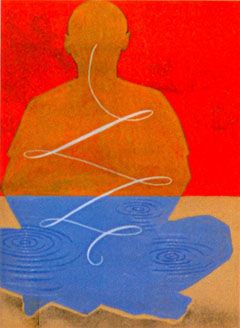Anxiety
Stop Your Anxiety Now!
Improve your performance and your relationships with this simple tool.
Posted May 20, 2013

If you struggle with worry and anxiety, you know all too well the toll it takes on your life. You might generate so much anxiety that you: are unable to talk with someone you are close with about a concern, appear more like a deer-in-the-headlights than a sharp candidate at a job interview, are practically paralyzed at the thought of doing a presentation for work, have poor concentration while taking an important exam; the list goes on and on. If you even remotely relate to this, you will want to know about square breathing. Though it won’t fix underlying issues that might be driving your anxiety, it can help you to relax, refocus, and move forward.
Once you learn square breathing, you can do it practically anywhere without anyone suspecting. It includes three components:
Diaphragmatic (or deep) breathing: Breathe in slowly, inflating your belly – much like inflating a balloon – rather than expanding your chest. Pause for a few seconds. Then slowly exhale, allowing your belly to deflate. Pause again before taking your next breath in. As you do this, you do not want your chest to expand. You might find it helpful to place one hand on your chest and one hand on your belly. If breathing in this way is difficult, you may find it easier to lie on your back with your knees in the air and your feet flat on the floor.
By itself, this can greatly reduce anxiety by calming your body. However, many people find that they continue to worry even as they breathe deeply and slowly. Their worry-driven thoughts stir their emotions, and so they are unable to relax or they quickly return to being tense and anxious. If this is the case for you, add this next step.
Square breathing: Breathe in for 5 seconds and imagine the side of a square being drawn. Then hold your breath for 5 seconds as you ‘see’ the next side of the square being completed. Exhale for 5 seconds, watching the third side of the square being drawn. And, hold for 5 seconds, watching the full square take form. If you have difficulty ‘seeing’ the square, feel free to just focus on counting each part of the breath. While focusing on your breath in these ways, you will find that you are not worrying about other things.
Practice square breathing ten times each day as part of a morning and/or evening routine. It can help you feel calmer at those times, as well as helping to build your proficiency at the technique. As you gain this expertise, you’ll find that you can effectively use square breathing at times during the day when you feel particularly anxious.
Refocus: A final important step in using this skill to reduce your anxiety is to consciously choose to refocus when you’ve completed the deep breathing. Chances are that your anxiety was being driven by “what ifs” or thoughts about the future. So, instead, think about the moment you are in. You might think about your surroundings; say, appreciating the beautiful, sunny day. Or, you might focus on what you need to do in the moment to get through some difficult task. For instance, you might remind yourself to make sure you have whatever documents you need for the meeting you are about to enter. In a more personal situation, you might remind yourself that your girlfriend has supportive friends as you prepare to tell her that you want to end things.
If your anxiety is part of an ongoing struggle, such as fear of rejection, then square breathing clearly won’t fix that issue. You will need to think about and face your personal struggles. However, in the process of thinking about that struggle and working it through, square breathing can help you to calm down at times when you become overwhelmed. It can help give you the strength to tolerate your feelings and to keep moving forward.
Because square breathing is such a simple skill to learn, it is also easy to dismiss as not particularly important. Don’t make this mistake. Take the time to learn square breathing; a basic, yet powerful tool that you will want in your personal toolbox.
Dr. Leslie Becker-Phelps is a clinical psychologist in private practice and is on the medical staff at Somerset Medical Center in Somerville, NJ. She also writes a blog for WebMD (The Art of Relationships) and is the relationship expert on WebMD’s Relationships and Coping Community.
If you would like email notification of new blog postings by Dr. Becker-Phelps, click here.
Making Change blog posts are for general educational purposes only. They may or may not be relevant for your particular situation; and they should not be relied upon as a substitute for professional assistance.
Personal change through compassionate self-awareness




